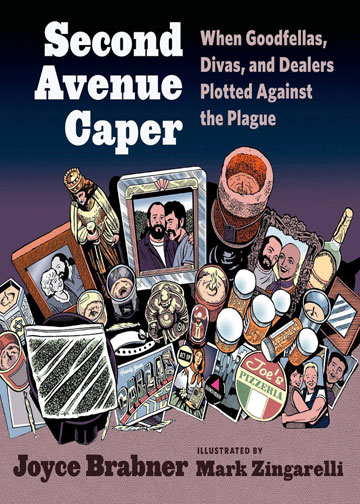Second Avenue Caper: When Goodfellas, Divas and Dealers Plotted Against the Plague
by Carolyn Marcille


SECOND AVENUE CAPER: WHEN GOODFELLAS, DIVAS AND DEALERS PLOTTED AGAINST THE PLAGUE
Joyce Brabner (Author), Mark Zingarelli (Illustrators), Hill and Wang (Publisher)
> Review by Carolyn Marcile
In “Little Beasts,” poet Richard Siken writes “History is a little man in a brown suit/trying to define a room he is outside of./I know history./There are many names in history/but none of them are ours.” Speaking as a gay man, Siken’s eloquent lines recall the historical erasure of queerness everywhere: at home, abroad, in culture, media and education. With Second Avenue Caper, Joyce Brabner has made an attempt to re-inscribe what has been written. Brabner is cartoonist Harvey Pekar’s widow; while Ms. Brabner may have grown weary of the consistent attachment of her talent to his, it is worth noting that it may be because of her name that the book was published. Brabner’s involvement speaks volumes about aforementioned historical erasure; that it takes a famous, straight white woman to get a book about queer AIDS activists published. Queer artists could have created this volume without Ms. Brabner’s involvement. But Brabner does her best to stand back and let the men and women involved in trying to ameliorate physical suffering, fear and prejudice during the early days of AIDS tell their stories. Rather than giving us a broad history of those early days, which might have resulted in this text being a dry, clinical affair, Brabner suffuses the text with essential human realness by speaking directly to those responsible for making the border runs for experimental drugs, for bearing witness to the decline of their friends, for realizing that the forced liminality they experience as queer members of society means that they will not be afforded even the most basic care expected by and afforded to straight individuals. It is the necessity of recording these oft-ignored perspectives that make Second Avenue Caper a potent example of the power of the individual in the face of almost unimaginable crisis. Raymond is Brabner’s main interview subject, and Mark Zingarelli’s simple black and white illustrations of him are undeniably striking. Ray is possessed of a most memorable kind of warm melancholy; drawings of him are a masterful combination of strength and sadness, of resilience and determination tempered by a sense of inevitable loss. To paraphrase Siken, Raymond is inside the box. Raymond knows history, and it is because of folks like him that Second Avenue Caper should be required reading. Its ability to testify to a period of history mainstream America is not often privy to is a step towards trying to make America better for everyone.
blog comments powered by Disqus|
Issue Navigation> Issue Index > v14n10 (Week of Thursday, March 12) > Graphic Traffic > Second Avenue Caper: When Goodfellas, Divas and Dealers Plotted Against the Plague This Week's Issue • Artvoice Daily • Artvoice TV • Events Calendar • Classifieds |









 Current Issue
Current Issue